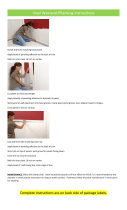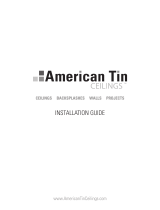Page is loading ...

Tools & Supplies You’ll Need For Most Installations:
- Safety Glasses - Tape Measure - Pencil - Hammer - Stud Finder - Drill (w 1/16” bit) - 8 p Finish Nails - Nail Set - Carpenter’s Square
- Miter Saw - Jig Saw - Circular or Table Saw - Caulk Gun - Painter’s Tape - Touch-up (putty or paint) - Construction Adhesive
UPREME
Wainscot System
S
Please read all the instructions and “Top Tips” before
installing your new Supreme Wainscot System.
It only takes a minute. Thanks.
Form # DC60-01121
Finish Up
Put your tools away & clean up the mess.
Any smudges can be cleaned with a mild spray cleaner on a soft cloth.
Now pat yourself on the back for a job well done!
Top Tips!
- Avoid wetting panels & trim while cleaning
by misting the cloth and not the wainscot.
Step 3: Install Chair Rail
Just like the Base, locate and mark the stud center lines so you know where to
attach the Chair Rail. Measure and t by starting at a corner or end. You may
need to miter cut the ends for inside and outside corners.
Pre-drill the Chair Rail with a 1/16” bit and attach it at each end and into every
other stud with 8 penny nish nails.
Top Tips!
- The Chair Rail shouldn’t rest on the panels. Use a length of Corner trim as a spacer
to hold an even Chair Rail height above the Base as you nail it.
- Painting the ends of the Chair Rail before installation with a matching color will
help hide the joints.
Touch-up
Now is the time to use your hammer and nail set to sink the
nails just below the surface of the trim.
Once set, use a matching wood putty stick or paint marker
to hide the nail holes.
Top Tips!
- For touch-up of un-painted trim & panels, we recommend either
Glidden - Raindrop White, 30GG 83/006, latex paint
or
Behr - Frost, 1857, latex paint.
Step 1: Install the Base Trim
Locate and mark the stud center lines studs so you know where to
attach the trim. Measure and t the Base by starting at a corner or
end. You may need to miter cut the ends for inside and outside corners.
Pre-drill the Base with a 1/16” bit and attach it at each end and into every
other stud with 8 penny nish nails.
Top Tips!
- When you have trim that’s mitered on one end, cut the miter rst then
cut the length from the square end.
- So you don’t accidently dent the trim faces, leave the nail heads slightly
above the surface. Later, you can use a nail set to sink them.
- Painting the ends of the Base before installation with a matching color will
help hide the joints.
- Don’t nail near electrical outlets or switches.
Step 2: Install the Panels & Corners
Start at either end of the wall and install the paneling using construction
adhesive. Three lines about 3/8” wide and 2’ long should be plenty.
Don’t jam the panels together. Try to make the joints look like the grooves.
Inside and outside Corners are installed after the paneling is done. Use
construction adhesive and painter’s tape to hold them until the glue sets.
Top Tips!
- For the best look you’ll want the end panels to be about equal in width
and large enough so the joint isn’t too close to the corner.
You can check rst by centering a panel on the wall (use painter’s tape to
hold it) and dry tting everything to one corner. That’ll show if you’re
OK to go, or if you instead need to center the panel edge on the wall.
- To help disguise the panel joints, always install paneling with its
tongue pointed toward the main view. Usually your room’s entrance.
Top Tip! If you choose to paint your Supreme Wainscot panels and trim, use only latex based paints.
Avoid latex based paint/primer combinations.
/








